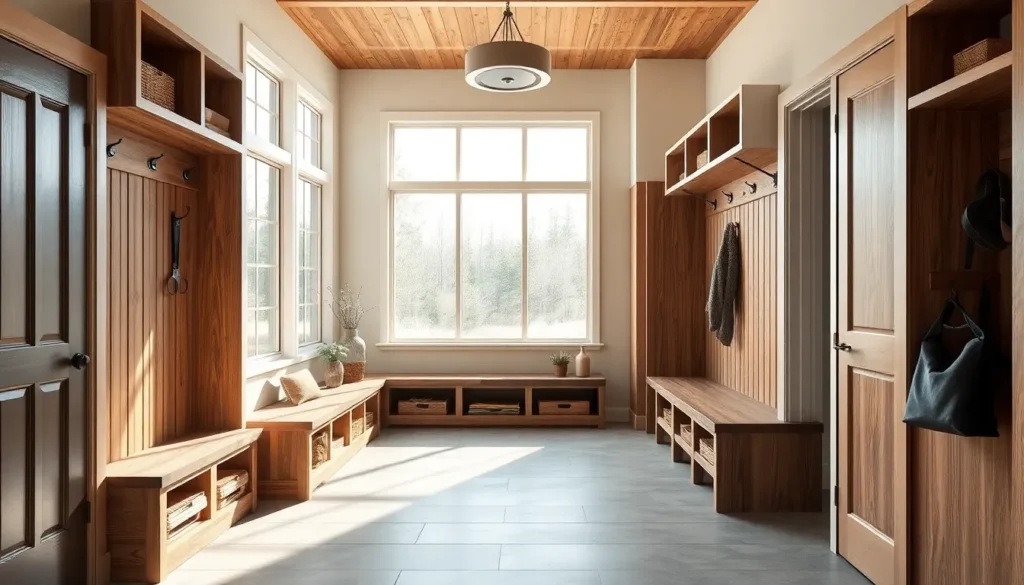We’ve all experienced that moment when muddy shoes and wet coats transform our pristine entryway into complete chaos. A well-designed mudroom isn’t just a luxury – it’s your home’s first line of defense against dirt, clutter, and the daily mess that comes with active living.
The right mudroom setup can revolutionize how your family enters and exits your home while keeping everything organized and accessible. From clever storage answers to stylish design elements, today’s mudroom ideas blend functionality with aesthetics to create spaces that actually make your life easier.
Whether you’re working with a spacious room or a compact nook by your back door, we’ll show you how to maximize every square inch with smart organization systems and design tricks that’ll make your neighbors jealous.
Essential Storage Solutions for Every Mud Room
Smart storage transforms chaotic entryways into organized spaces that work seamlessly for busy families. We’ve identified three fundamental storage categories that form the backbone of any successful mud room design.
Built-In Cubbies and Lockers
Built-in cubbies create designated spaces for each family member’s belongings while maintaining visual order. We recommend installing cubbies that measure 12-15 inches wide and 18-24 inches deep to accommodate backpacks, sports equipment, and seasonal gear effectively.
Custom lockers offer maximum organization potential with these key features:
- Adjustable shelving allows flexibility as storage needs change throughout the year
- Ventilated doors prevent moisture buildup from wet shoes and damp clothing
- Name labels help family members maintain their assigned spaces consistently
- Lower compartments provide easy access for children to store their daily essentials
Professional installation typically costs $300-800 per cubby unit depending on materials and complexity. We’ve found that laminate construction offers durability at $300-500 per unit while solid wood options range from $600-800.
Wall-Mounted Hooks and Racks
Wall-mounted storage maximizes vertical space without consuming valuable floor area in compact mud rooms. We position hooks 48-54 inches from the floor for adult accessibility and 36-42 inches for children’s items.
Strategic hook placement includes these essential configurations:
- Double hooks handle heavy winter coats and multiple lightweight jackets efficiently
- Flip-down hooks stay flat against walls when not in use
- Rail systems accommodate varying numbers of items throughout different seasons
- Specialty hooks designed for umbrellas, dog leashes, and reusable shopping bags
Quality hook systems support 15-25 pounds per hook when properly anchored into wall studs. We install heavy-duty options that cost $25-60 per linear foot depending on material quality and design complexity.
Bench Seating with Hidden Storage
Bench seating provides comfortable spots for putting on shoes while concealing seasonal items beneath hinged tops. We recommend bench heights of 17-19 inches for optimal comfort during daily use.
Multi-functional bench designs incorporate these practical elements:
- Cushioned tops enhance comfort during longer tasks like tying boots or organizing bags
- Divided compartments separate different types of stored items effectively
- Soft-close hinges prevent slamming and protect stored contents from damage
- Water-resistant finishes withstand moisture from wet boots and umbrellas
Standard bench storage holds approximately 3-5 cubic feet of items per linear foot. We’ve installed benches ranging from $200-600 depending on construction materials and built-in organizational features.
Flooring Options That Handle Heavy Traffic
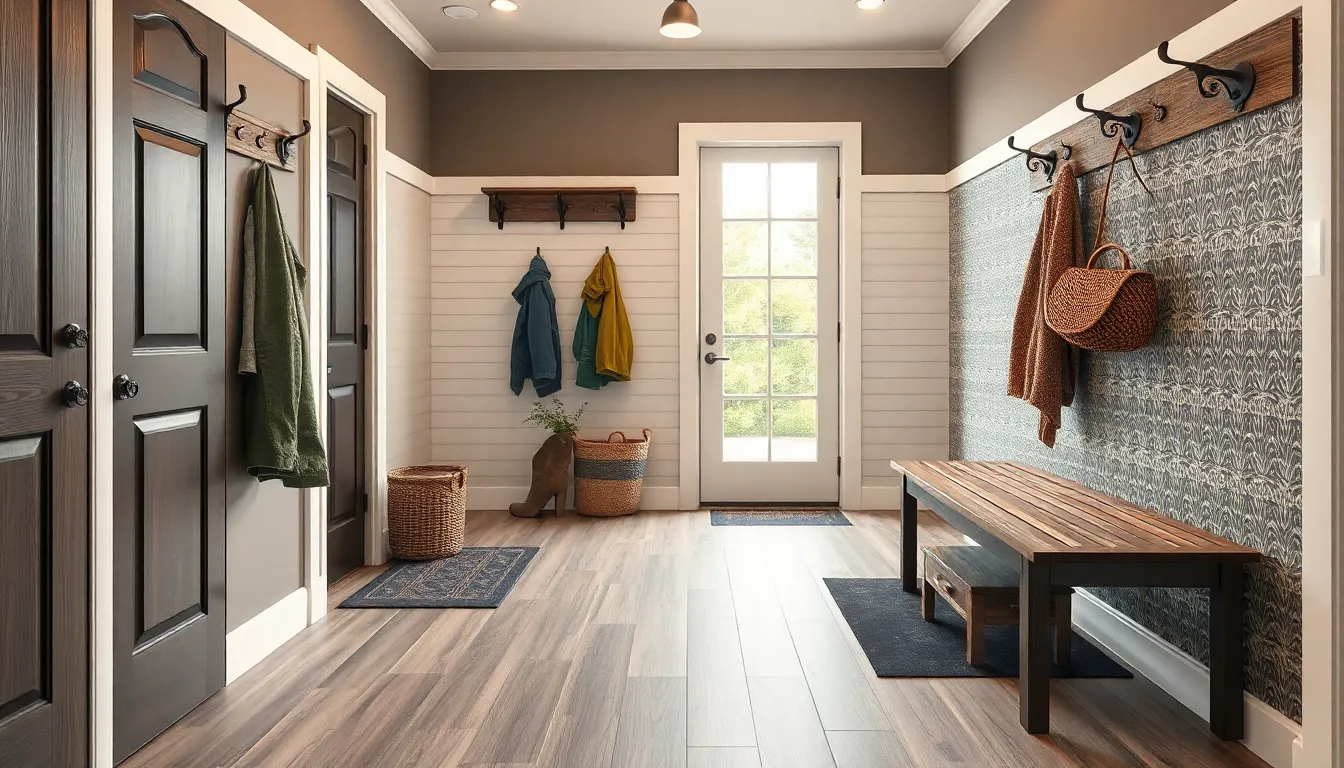
Mudroom floors endure constant abuse from wet boots, muddy paws, and heavy foot traffic. We’ve identified the most durable flooring materials that can withstand these daily challenges while maintaining their appearance and functionality.
Durable Tile and Stone Choices
Ceramic and porcelain tiles top our list for mudroom durability and practicality. These materials resist water damage completely and clean up with simple mopping, making them ideal for spaces that see constant moisture exposure. Porcelain tiles offer exceptional strength compared to ceramic options, with some varieties designed specifically for high traffic areas that experience over 500 footsteps daily.
Natural stone flooring provides unmatched durability for homeowners seeking luxury aesthetics. Slate and granite options resist scratching and chipping while offering slip resistant surfaces that protect family members during wet weather. Stone materials require sealing every 2-3 years to maintain their water resistance properties.
Slip resistant tile options enhance safety in mudrooms where wet conditions create hazardous walking surfaces. Manufacturers now produce textured ceramic tiles with coefficient ratings above 0.6, meeting commercial safety standards for areas prone to moisture accumulation.
Water-Resistant Vinyl and Laminate
Luxury vinyl planks (LVP) deliver the warmth of hardwood appearance without moisture vulnerability. These planks withstand standing water for up to 24 hours without warping or damage, making them perfect for mudrooms where snow and rain create puddles. LVP installation costs average $3-7 per square foot including professional installation.
Luxury vinyl tiles (LVT) offer similar durability in tile format for homeowners preferring geometric patterns. LVT products feature wear layers that resist scratching from pet claws and heavy objects, maintaining their appearance through years of mudroom abuse.
Laminate flooring provides a budget friendly alternative that handles moderate moisture exposure. Modern laminate products include waterproof core layers that protect against spills and humidity, though they perform best when excess water gets cleaned promptly rather than left standing.
Easy-to-Clean Concrete Answers
Sealed concrete floors transform basic concrete into practical mudroom surfaces through protective coating applications. Professional sealing treatments create water resistant barriers that prevent staining and make daily cleaning effortless with standard mops and cleaners.
Polished concrete options combine durability with modern aesthetics through grinding and sealing processes. These surfaces reflect light to brighten mudroom spaces while providing completely waterproof flooring that never needs replacement. Polished concrete installation ranges from $5-12 per square foot depending on decorative treatments.
Epoxy coated concrete adds color and pattern possibilities to basic concrete foundations. Epoxy applications create seamless surfaces without grout lines where dirt accumulates, and they resist chemicals from de-icing salts that family members track inside during winter months.
Smart Organization Systems for Seasonal Items

Managing seasonal items requires thoughtful storage answers that keep our mudrooms functional year-round. We’ve identified the most effective strategies to organize rotating wardrobes and equipment while maximizing accessibility.
Rotating Shoe Storage Ideas
Shoe cubbies provide the foundation for organized footwear storage in busy mudrooms. Open cubbies offer easy visibility and quick access, making it simple for family members to grab their shoes on the way out. We recommend installing cubbies at varying heights to accommodate different shoe sizes and family members.
Rotating shoe racks maximize storage capacity in compact mudroom spaces. These innovative answers allow us to store multiple pairs of shoes in the footprint of traditional static storage. The rotating mechanism ensures every pair remains accessible without having to move other shoes around.
Seasonal shoe rotation becomes effortless when we designate exact cubbies for current season footwear while storing off-season shoes in closed storage areas. This system keeps our most-used shoes at eye level while maintaining an organized appearance.
Coat and Jacket Management
Individual lockers create designated spaces for each family member’s outerwear collection. Open lockers with built-in hooks ensure coats and bags have dedicated homes, preventing the common problem of garments piling up on shared hooks. We find that personal storage spaces encourage family members to maintain organization.
Wall hooks positioned near doorways offer immediate access for frequently used jackets and coats. Strategic placement at various heights accommodates different family members while keeping the most-used items within easy reach. This approach works particularly well for daily-use coats and light jackets.
Closed storage units hide seasonal outerwear when it’s not in use, maintaining a clean mudroom appearance. Winter coats during summer months or rain gear during dry seasons can be stored out of sight in designated cabinets or bins, freeing up space for current season items.
Sports Equipment Organization
Custom storage answers address exact sports equipment needs through purpose-built shelves and cabinets. We recommend designing storage based on our family’s activities, whether that’s hockey gear, tennis rackets, or soccer equipment. Custom builds ensure every piece of equipment has its proper place.
Hooks accommodate larger sports items like bicycles, tennis bags, and hockey sticks. Wall-mounted hooks at appropriate heights keep bulky equipment off the floor while maintaining easy access for regular use.
Baskets organize smaller sports gear including balls, gloves, protective equipment, and accessories. Labeled baskets grouped by sport or family member create an efficient system where everything has a designated home. This approach prevents small items from getting lost in the shuffle of larger equipment.
Budget-Friendly DIY Mud Room Projects

Creating a functional mudroom doesn’t require a major renovation or expensive custom installations. We can transform any entryway into an organized space using materials we already have and simple DIY techniques that cost a fraction of professional answers.
Repurposed Furniture Transformations
Old dressers become wall-mounted storage powerhouses when we convert them into custom mudroom organizers. We can repaint antique dressers and mount them on walls, then add hooks or baskets to the exterior for additional hanging storage. Removing drawers creates open cubbies perfect for shoes and boots.
Wooden pallets transform into comfortable bench seating with minimal effort and maximum impact. We simply stack pallets to create the base structure, then add cushions on top for comfort and storage bins underneath for seasonal items. This solution costs under $50 and provides both seating and hidden storage.
Repurposed cabinets serve as instant mudroom lockers when we mount them at appropriate heights for family members. We can paint them to match our decor and install additional hooks inside the doors for bags and accessories.
Simple Shelving and Hook Installations
Strategic hook placement maximizes vertical wall space while keeping coats, bags, and accessories organized and off the floor. We install hooks at varying heights to accommodate different family members, using sturdy wall anchors that support up to 20 pounds each.
DIY shelving using reclaimed wood creates affordable storage for hats, gloves, and other small items that tend to clutter entryways. We can build simple floating shelves for under $20 per shelf using basic lumber and wall brackets.
Board and batten walls add character while increasing storage capacity through an inexpensive installation process. We install vertical boards spaced 12-16 inches apart, creating natural divisions for hooks and small shelves between each section.
Painted Storage Answers
Colorful storage bins add personality while maintaining organization when we paint plain baskets or containers to match our mudroom’s color scheme. We use spray paint designed for plastic or wicker to ensure durability and easy cleaning.
Faux finish techniques create designer looks on budget-friendly surfaces like plain drywall or plywood. We can apply faux brick or German Schmear techniques to create textured backdrops that complement our storage answers and add visual interest for under $30 in materials.
Painted labels on storage containers eliminate guesswork while maintaining a cohesive design aesthetic. We use chalkboard paint or vinyl lettering to clearly mark bins for exact items like winter accessories, sports equipment, or pet supplies.
Lighting and Ventilation Upgrades
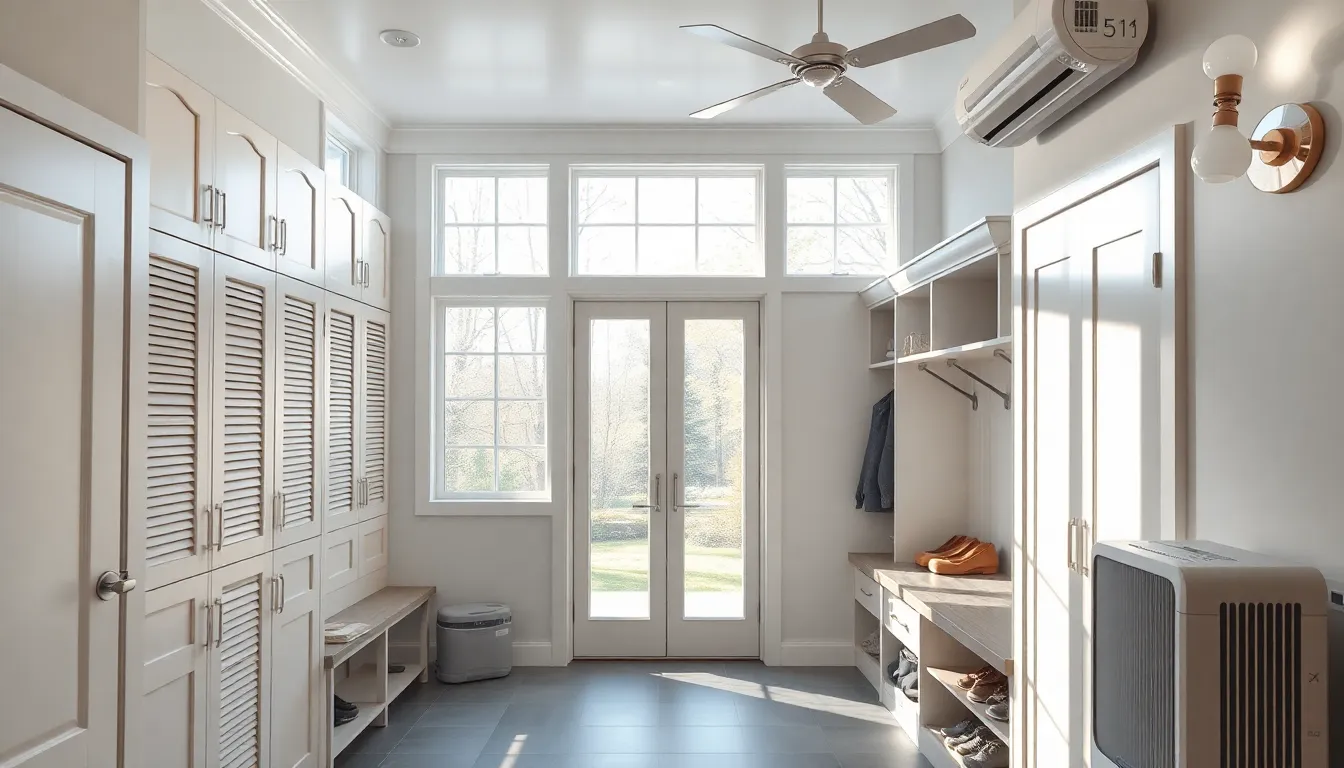
Creating a comfortable and functional mudroom requires thoughtful attention to lighting and air quality. These upgrades ensure your space remains welcoming while effectively managing moisture and providing adequate visibility.
Natural Light Maximization
Windows become your mudroom’s best friend when strategically placed to flood the space with daylight. Large windows positioned near the main entrance create an inviting atmosphere while reducing dependency on artificial lighting during daytime hours.
Skylights offer exceptional light coverage in mudrooms with suitable ceiling access. Installing skylights directly above high traffic areas ensures even illumination throughout the space while creating an open, airy feeling.
Glass doors connecting to outdoor spaces extend natural light deeper into your mudroom. These installations work particularly well when your mudroom serves as a transition between your home’s interior and a patio or deck area.
Proper Air Circulation Systems
Exhaust fans vented outdoors effectively remove moisture and odors that accumulate from wet clothing and footwear. Installing fans with adequate CFM ratings ensures proper air exchange rates for your mudroom’s square footage.
Dehumidifiers maintain optimal humidity levels to prevent mildew and mold growth in storage areas. These systems work continuously to extract excess moisture from the air, protecting both stored items and building materials.
Storage space ventilation prevents odor buildup from shoes, sports equipment, and seasonal clothing. Incorporating ventilated cabinet doors and breathable storage answers keeps air circulating around stored items.
Radiant heating systems accelerate drying of wet items while maintaining comfortable temperatures. These installations work beneath flooring materials like marble tiles, which conduct heat efficiently and simplify cleaning routines.
Task Lighting for Daily Use
Overhead lighting provides general illumination for the entire mudroom space during evening hours and overcast days. Installing fixtures with dimmer controls allows you to adjust brightness based on exact tasks and time of day.
Sconces mounted at strategic heights offer targeted lighting for coat hanging, shoe organization, and locker access. Positioning these fixtures near storage areas eliminates shadows that make finding items difficult.
Built in cabinet lights illuminate storage interiors where overhead lighting can’t reach effectively. LED strip lights installed inside cubbies and lockers ensure you can easily locate items stored in deeper areas.
Decorative fixtures like table lamps add ambiance while serving practical lighting needs. Collections such as Crystorama Solaris offer stylish options that complement your mudroom’s design aesthetic while providing necessary task lighting.
Color Schemes and Design Themes
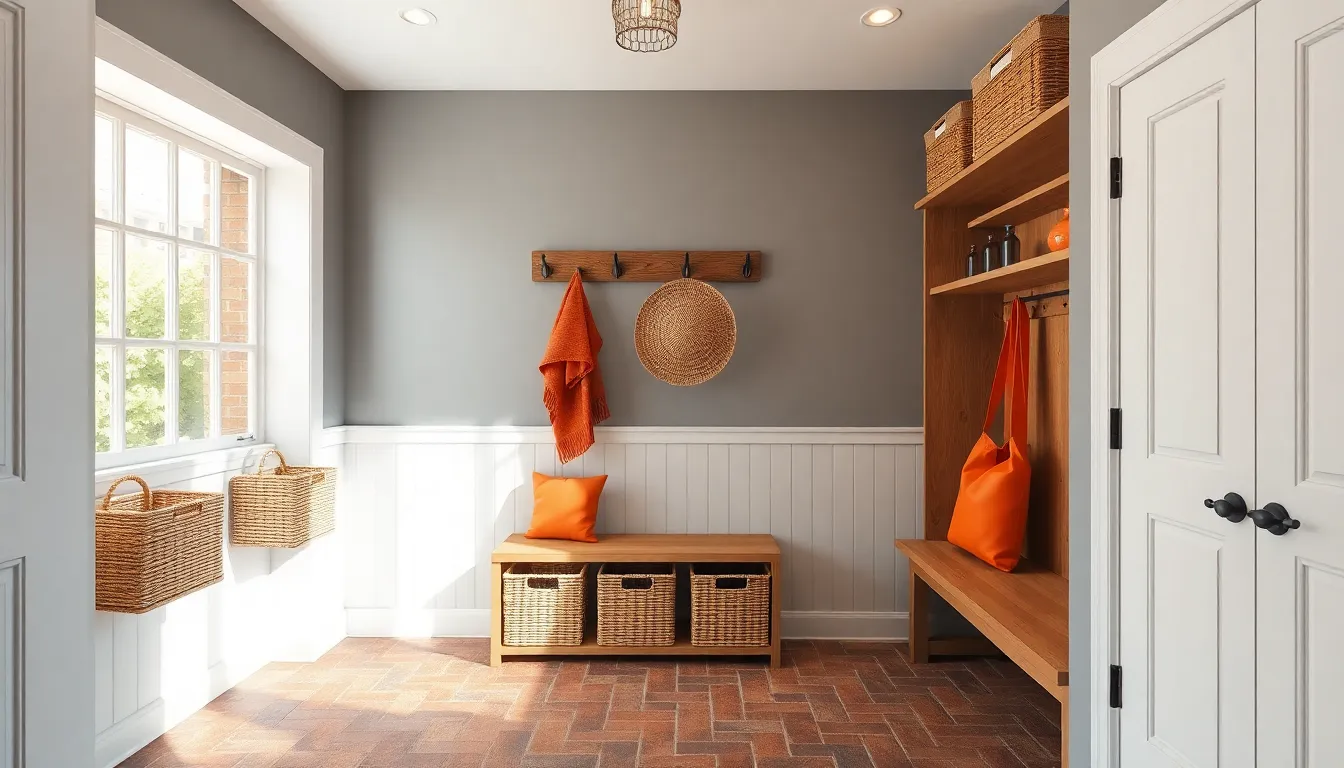
Choosing the right color palette and design theme transforms your mudroom from a purely functional space into an extension of your home’s overall aesthetic. We’ll explore three distinct approaches that can elevate your mudroom while maintaining its practical purpose.
Neutral and Calming Palettes
Benjamin Moore Chelsea Grey creates a sophisticated atmosphere that perfectly balances functionality with refined style. This versatile shade works exceptionally well in mudrooms where you want to maintain a sense of calm even though the daily hustle and bustle.
Farrow and Ball Downpipe offers exceptional versatility when paired with rich wood elements throughout your space. We’ve found this gray tone provides the perfect neutral backdrop that allows natural materials to shine while maintaining visual sophistication.
Light grays and whites deliver an instantly refreshing feel that makes even compact mudrooms appear more spacious and airy. These colors prove particularly effective in spaces with limited natural light, as they reflect available illumination and create an welcoming atmosphere for busy family transitions.
Bold and Energizing Options
Moody blue green hues inject vibrant energy into your mudroom while symbolizing nature and growth throughout the seasons. We recommend pairing these ever-changing shades with warm terracotta accents to create a complementary color story that feels both bold and balanced.
Bold wallpaper patterns add instant personality to mudroom walls while creating visual interest in an otherwise utilitarian space. Consider geometric designs or botanical prints that can withstand the wear and tear of daily family traffic.
Strategic color pops through flooring choices offer another effective way to introduce energy without overwhelming the space. Brightly colored tiles or painted concrete can serve as statement elements that energize your daily routine.
Rustic and Farmhouse Styles
Natural woods combined with rattan storage baskets create the perfect foundation for achieving that coveted farmhouse aesthetic. We love how this combination maintains functionality while introducing organic textures that feel both cozy and purposeful.
Herringbone brick floors deliver authentic rustic charm that complements wooden beams and built in storage answers beautifully. This flooring pattern adds visual interest while providing the durability needed for high traffic mudroom areas.
Matte black hardware provides striking contrast against lighter farmhouse elements like natural wood and woven baskets. We’ve seen this combination create sophisticated depth while maintaining the relaxed, welcoming feel that defines farmhouse design.
Multi-Functional Furniture Ideas
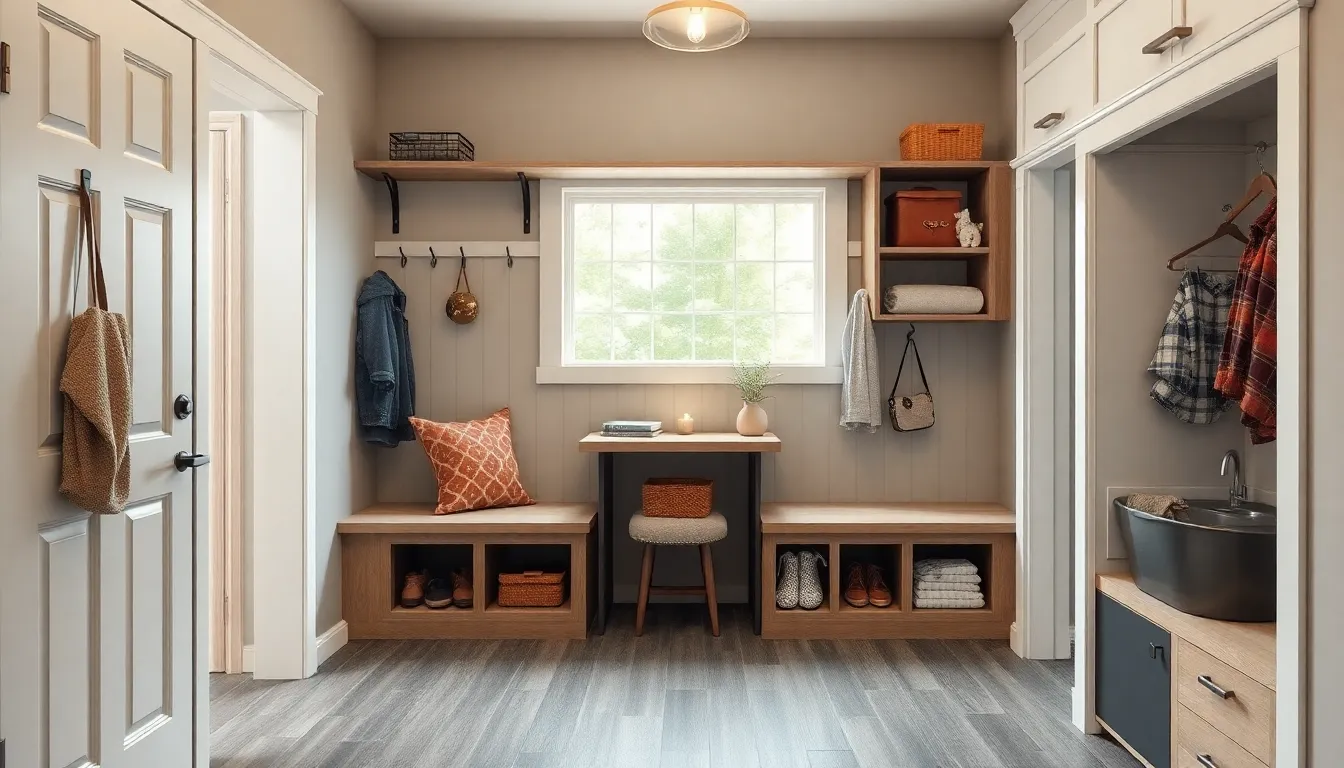
Maximizing mudroom functionality becomes achievable when we integrate furniture pieces that serve multiple purposes. Smart furniture selections transform even compact entryways into highly organized spaces.
Convertible Bench Designs
Storage benches with flip-top compartments offer dual functionality by providing seating while concealing sports equipment, gloves, and scarves beneath hinged tops. We recommend measuring your available space before selecting bench dimensions to ensure comfortable seating height and adequate storage capacity.
Foldable benches excel in smaller mudrooms where space flexibility matters most. These designs fold flat against walls when not needed, instantly creating more floor space for busy mornings. Installation requires simple wall mounting brackets that support weight when the bench is in use.
Modular bench systems adapt to changing family needs through adjustable configurations. Components can be rearranged seasonally, accommodating everything from winter boots to summer sports gear with removable dividers and expandable sections.
Drop-Zone Desk Areas
Built-in desks or countertops create designated landing zones where family members can immediately organize keys, mail, and daily essentials upon entering. We suggest incorporating electrical outlets within these areas to support device charging and small appliances.
Overhead hook and shelf combinations maximize vertical space above desk surfaces for hanging bags while storing frequently accessed items within arm’s reach. Strategic placement ensures bags don’t interfere with desk functionality while remaining easily accessible.
Mail sorting stations integrate seamlessly into desk designs through built-in organizers, file holders, and small drawers. These features prevent paper clutter from accumulating on surfaces while maintaining quick access to important documents.
Pet Care Stations
Pet washing areas transform mudrooms into grooming spaces by incorporating handheld showers or small sinks specifically designed for cleaning pets after outdoor activities. Waterproof surrounds and proper drainage ensure easy maintenance while preventing water damage.
Built-in feeding stations eliminate scattered pet bowls through integrated storage answers that house food containers and water dispensers. Elevated feeding platforms reduce mess while built-in storage bins keep pet food fresh and organized.
Pet storage answers use dedicated shelves and bins for organizing toys, treats, leashes, and grooming accessories within easy reach. We recommend choosing materials that resist pet hair accumulation and can withstand regular cleaning for long-term durability.
Small Space Mud Room Solutions

Small spaces don’t have to compromise functionality when it comes to creating an organized entryway. We’ll show you how strategic storage answers can transform even the tiniest mud room into a highly efficient organizational hub.
Vertical Storage Maximization
Wall-mounted hooks create instant organization by utilizing every inch of vertical space without claiming precious floor area. Installing hooks at different levels allows family members of various heights to access their belongings easily while accommodating everything from coats and hats to purses and leashes.
Floating shelves maximize storage capacity by drawing the eye upward and creating multiple levels of organization. Mounting shelves with doors provides hidden storage for clutter prone items like gloves and seasonal accessories, keeping your space looking clean and uncluttered.
Wall-mounted cabinets offer enclosed storage for cleaning supplies and accessories without sacrificing any floor space. These cabinets work particularly well above bench seating areas, creating a complete storage wall that serves multiple organizational purposes.
Corner Utilization Strategies
Corner shelves transform typically wasted spaces into valuable storage areas perfect for small items like gloves, scarves, and keys. Positioning corner baskets at various heights creates multiple storage zones that keep frequently used items within easy reach.
Corner hooks provide clever answers for hanging bags, hats, and other items that challenge traditional storage methods. Installing hooks in both upper and lower corner positions doubles your hanging capacity while maintaining easy access to daily essentials.
Angled storage units fit perfectly into corner spaces and can accommodate everything from umbrellas to sports equipment. These specialized units often feature multiple compartments that keep different types of items separated and organized.
Compact Organization Systems
Storage benches with lids serve dual purposes by providing comfortable seating for putting on shoes while hiding clutter like seasonal gloves and hats underneath. These benches work especially well in narrow spaces where traditional furniture might feel overwhelming.
Wicker baskets add farmhouse charm while offering practical storage for less frequently used items. Positioning these baskets on shelves or sliding them under benches keeps floors clear while maintaining easy access to stored belongings.
Slim storage units fit into narrow spaces and provide ample storage without overwhelming compact areas. Wall-mounted bins and baskets group similar items together while keeping floors clear and making everything easily accessible for daily use.
Technology Integration for Modern Mud Rooms
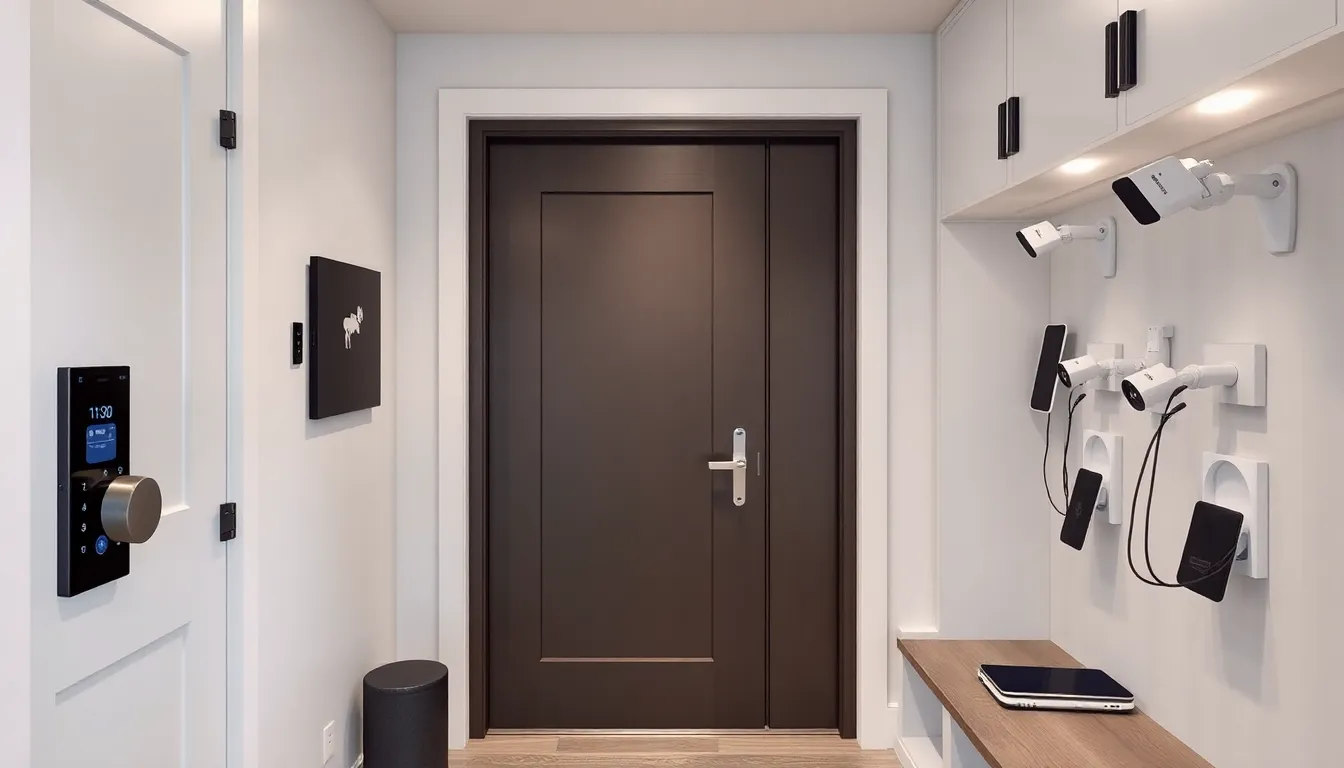
Modern mudrooms can benefit from cutting edge technology answers that enhance convenience and organization. Smart features transform these transitional spaces into highly functional command centers for busy families.
Smart Home Features
Automated lighting systems respond to motion sensors and provide hands free illumination when your arms are full of groceries or sports equipment. Smart switches allow you to adjust brightness levels throughout the day and create custom lighting schedules that welcome you home after dark.
Smart locks offer keyless entry options through smartphone apps, keypads, or fingerprint scanners. These systems eliminate the need to fumble for keys while managing children and packages, and they provide remote access control for family members and service providers.
Climate control integration connects your mudroom to your home’s HVAC system through smart thermostats and humidity sensors. Automated ventilation systems activate when moisture levels rise, preventing mold growth and maintaining air quality in this high traffic area.
Charging Stations and Device Storage
Built in charging stations keep electronic devices organized and powered up for daily use. Install USB outlets and wireless charging pads inside drawers or cubbies to create dedicated spaces for phones, tablets, and smartwatches without visible cord clutter.
Device storage answers include lockable compartments for valuable electronics and open shelving for everyday items. Shallow drawers with velvet lined compartments protect screens from scratches, while adjustable dividers accommodate devices of various sizes.
Cable management systems route charging cords through hidden channels and grommets to maintain a clean appearance. Pop up outlets installed in benchtops provide convenient access to power while remaining concealed when not in use.
Security and Monitoring Options
Security cameras positioned at entry points provide real time monitoring of your home’s main access areas. Indoor cameras with night vision capabilities capture clear footage regardless of lighting conditions, and cloud storage options ensure recordings remain accessible even during power outages.
Smart doorbells with integrated cameras offer two way communication and motion detection alerts sent directly to your smartphone. These devices record visitor activity and package deliveries, providing peace of mind when you’re away from home.
Motion sensors trigger automated responses like turning on lights or sending security alerts when unexpected movement occurs. Integration with your home security system creates comprehensive monitoring that extends from the mudroom throughout your property.
Seasonal Decoration and Maintenance Tips

Maintaining a functional mudroom throughout the year requires strategic planning for changing weather conditions and seasonal storage needs. We’ll explore practical approaches to keep your mudroom organized and efficient regardless of the season.
Weather-Appropriate Accessories
Spring accessories refresh your mudroom with vibrant elements like new area rugs and spring themed pillows that welcome the warmer months. Adding real plants creates a fresh atmosphere while providing natural air purification for your entryway space.
Fall preparations transform your mudroom into a cozy seasonal hub with accessories like decorative pumpkins and dried grasses. Installing a warm lamp illuminates darker autumn days while a woven basket corrals seasonal items like scarves and lightweight jackets.
Winter essentials include waterproof boot trays that protect your flooring from snow and salt residue. Strategic placement of hooks accommodates heavy winter coats and snow gear while storage benches provide convenient seating for boot removal.
Summer adaptations focus on lightweight storage answers and cooling elements like portable fans or window shades. Breathable storage baskets replace heavy winter containers while lighter colored accessories reflect heat and brighten the space.
Easy Cleaning Routines
Daily maintenance involves quick pickup sessions where family members return shoes to designated cubbies and hang coats on assigned hooks. This five minute routine prevents clutter accumulation and maintains visual organization.
Weekly cleaning requires vacuuming high traffic areas and dusting storage surfaces to remove accumulated dirt and debris. Wiping down bench surfaces and sanitizing frequently touched hooks maintains hygiene standards.
Monthly deep cleaning includes organizing storage compartments and sanitizing all surfaces with appropriate cleaning answers. Rotating seasonal items during these sessions ensures your mudroom adapts to changing weather needs.
Quarterly maintenance involves evaluating storage systems for wear and replacing damaged components like worn door mats or broken hooks. This proactive approach prevents larger maintenance issues from developing.
Seasonal Storage Rotation
Spring summer transitions require storing heavy winter items like insulated boots and down coats in upper cabinets or basement storage areas. Bringing out lighter rain gear and spring jackets keeps frequently used items accessible.
Fall winter preparations involve retrieving warm weather gear from summer storage while packing away lightweight items. Strategic rotation ensures winter essentials like thermal gloves and snow boots occupy prime storage locations.
Storage timing typically occurs during mild weather periods when families aren’t actively using seasonal items. Planning these rotations around school schedules and weather forecasts maximizes efficiency.
Inventory management includes labeling storage containers with contents and rotation dates to streamline future seasonal changes. This system prevents forgotten items from occupying valuable storage space unnecessarily.
Conclusion
We’ve explored countless ways to transform your mudroom from a chaotic catch-all into an organized sanctuary that welcomes you home. Whether you’re working with a spacious entryway or a compact corner these ideas prove that smart design choices make all the difference.
The key to mudroom success lies in combining practical storage answers with your personal style. From built-in lockers to smart technology integration every element should serve both form and function.
Remember that creating your ideal mudroom doesn’t require a massive budget or complete renovation. Start with one or two improvements that address your family’s biggest challenges and build from there. With proper planning and the right combination of storage organization and design elements your mudroom will become one of the hardest-working spaces in your home.
Frequently Asked Questions
What is the main purpose of a mudroom?
A mudroom serves as a practical transition space between the outdoors and your home’s interior. It helps manage dirt, clutter, and moisture while providing organized storage for coats, shoes, bags, and seasonal items. A well-designed mudroom keeps your main living areas cleaner and creates an efficient entry and exit system for busy families.
What are the essential storage solutions for a mudroom?
The three fundamental storage categories include built-in cubbies and lockers for designated family member spaces, wall-mounted hooks and racks to maximize vertical storage, and bench seating with hidden storage compartments. These solutions transform chaotic entryways into organized spaces while accommodating various items like coats, shoes, bags, and seasonal gear.
What flooring materials work best in mudrooms?
Durable, water-resistant materials are ideal for mudrooms. Ceramic and porcelain tiles resist moisture and are easy to clean. Natural stone like slate offers luxury aesthetics, while luxury vinyl planks (LVP) provide warmth without moisture vulnerability. Sealed concrete and slip-resistant tiles enhance safety and durability for high-traffic areas.
How can I organize seasonal items in my mudroom?
Implement rotating storage systems with open cubbies for visibility and seasonal rotation strategies. Use individual lockers for coats and jackets, labeled baskets for small items, and custom storage solutions for sports equipment. Consider modular systems that adapt to changing seasonal needs while maintaining year-round functionality.
Can I create a functional mudroom on a budget?
Yes, budget-friendly DIY projects can transform your space without major renovations. Repurpose old furniture, install simple shelving systems, and upgrade lighting with affordable fixtures. Focus on essential storage solutions like wall hooks, floating shelves, and storage benches that provide maximum organization without breaking the bank.
How do I maximize space in a small mudroom?
Utilize vertical storage with wall-mounted hooks and floating shelves. Implement corner utilization strategies with corner shelves and compact organization systems. Choose multi-functional furniture like storage benches with lids and slim storage units that maintain functionality without overwhelming the limited space available.
What color schemes work best for mudroom design?
Neutral and calming palettes like Benjamin Moore Chelsea Grey create sophisticated atmospheres. Bold and energizing options including moody blue-green hues add personality. Rustic and farmhouse styles with natural woods and organic textures maintain functionality while creating an inviting aesthetic that complements your home’s overall design.
How can I integrate technology into my mudroom?
Modern mudrooms benefit from smart home features like automated lighting systems, smart locks for keyless entry, and climate control integration. Built-in charging stations keep electronics organized, while security options like smart doorbells provide convenience. These technological upgrades enhance both functionality and home security.
What maintenance routine should I follow for my mudroom?
Implement daily maintenance with quick tidying and weekly deep cleaning of surfaces. Monthly tasks should include organizing storage areas and seasonal rotation of items. Focus on easy cleaning routines that address moisture management, maintain hygiene, and keep organizational systems functioning effectively throughout the year.
How do I adapt my mudroom for different seasons?
Plan weather-appropriate accessories for each season, from vibrant spring elements to cozy fall decorations. Include winter essentials like waterproof boot trays and summer cooling adaptations. Implement seasonal storage rotation strategies to efficiently manage changing weather needs while keeping the space functional and clutter-free year-round.

